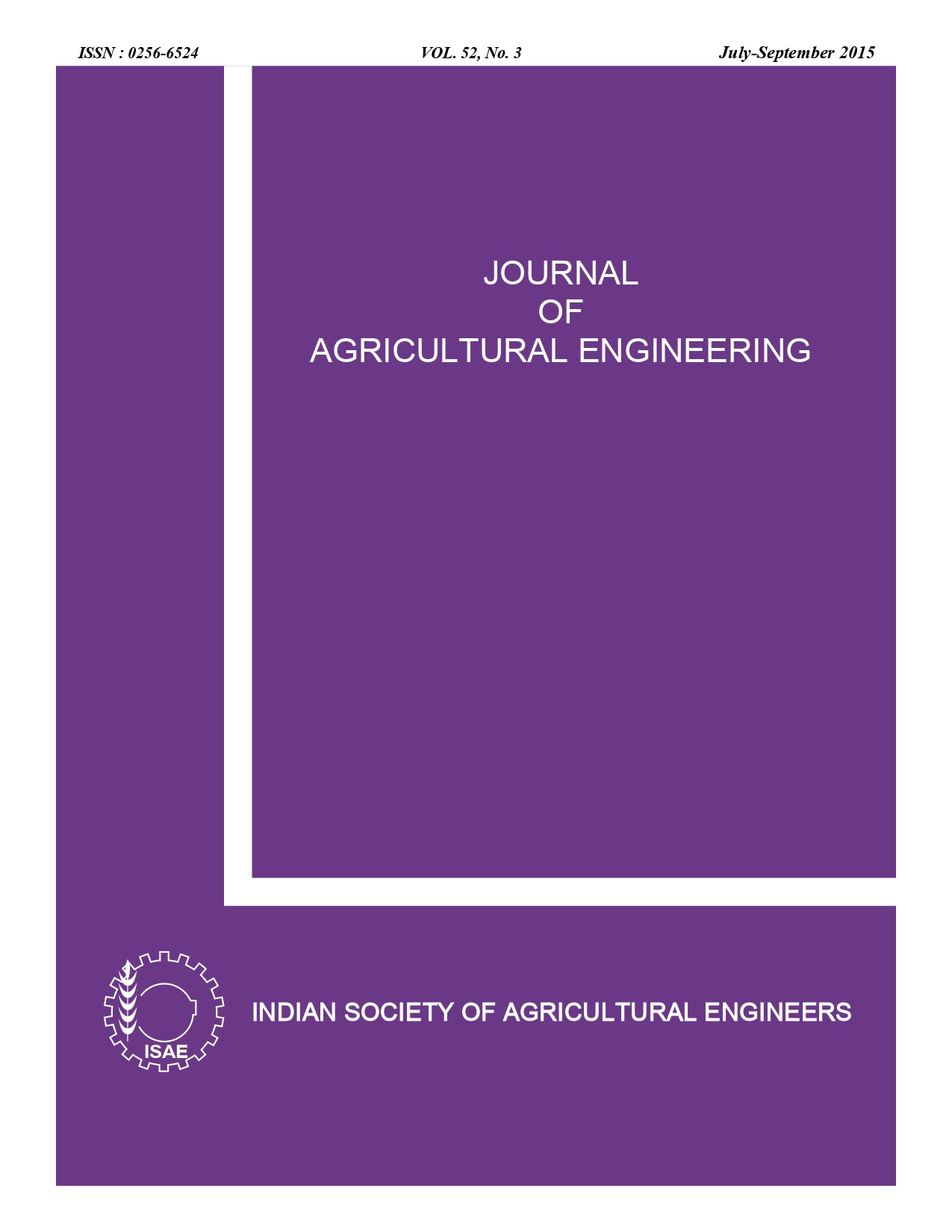Optimal Water Resource Planning for Waterlogged Cropped Land
DOI:
https://doi.org/10.52151/jae2015523.1580Keywords:
Water resources, waterlogged crop area, Markov Chain, multi-objective programming, crop planAbstract
Development plan of water resources in a surface waterlogged area in coastal district of Odisha, India was attempted. Vulnerability extent of dry spell was to the tune of 17-55 % during monsoon season using Markov chain procedure, which emphasized the requirement of micro-level water resources plan in the study area. Through field survey procedure, four farm pond locations were suggested for farm ponds in 41 ha command area. Further, the CAD&WM, DOWR, Govt. of Odisha executed field drain and helped in modulating water congestion in the crop fields and enhanced paddy yield ranging between 2.3-3.1 t.ha-1 as against 1.2 t.ha-1 under pre-drainage condition. Due to successful functioning of the surface drainage system, reduction of ponding up to 49 cm in paddy field took place in a peak rainfall event of 152 mm, when field drain observed 109 cm inundation. Renovation of minors helped in regaining their carrying capacity, which ranged between 0.9-1.63 m3 .s-1. Applying multi-objective programming technique with water availability at 75% and 85% scenarios, the optimal crop allocation was found at 75 % level, which suggested growing of kharif paddy in 20 ha, rabi tomato in 24.1 ha and rabi brinjal in 5.9 ha with maximum profit and production. Thus, due to execution of field drain and rejuvenation of farm ponds and minors in the command area, rabi crops were successfully introduced with varying successes.
References
Anon. 2006. http://kendrapara.nic.in/govtdeptt/agriculture.html. Accessed on 30.04.2013
Anon. 1986. http://www.fao.org/docrep/S2022E/S2022E00.htm. Accessed on 30.04.2013
Chow V T. 1964. Handbook of Applied Hydrology. McGraw Hill Book co., New York, U.S.A, pp:1453.
Doorenbos J; Pruitt W O. 1992. Crop water requirements. FAO Irrigation and Drainage Paper 24, pp: 144.
Gupta S K. 1983. Evaluation of leaching and resalinization behaviour of saline soils in relation to crop growth. Annual Report, CSSRI, Karnal, 114- 115.
Hargreaves G H. 1994. Defining and using reference evapotranspiration. ASCE J. Irrig. Drain. Eng., 120 (60), 1132-1139.
Hargreaves G L; Hargreaves G H; Riley J P. 1985. Agricultural benefits for Senegal river basin. ASCE J. Irrig. Drain. Eng., 111 (2),113-124.
Mishra A; Adhikary A K; Mohanty R K; Anand P S B; Ghosh S; Panda S N; Kumar A. 2010. Performance Enhancement of a Minor Irrigation System through Secondary Storage and Multiple Use Management. Research Bulletin No. 49, Directorate of Water Management (Indian Council of Agricultural Research), Chandrasekharpur, Bhubaneswar - 751023, India, pp : 38.
Panda R K; Singh Rajbir; Kar G; Kumar A. 2011. Resources appraisal of coastal paddy ecosystem of Orissa– A case study. In: Raychaudhuri et al. [Eds] Souvenir, Seminar on Water Use in Agriculture: Challenges Ahead. Indian Society of Water Management, Orissa Chapter, Directorate of Water Management (Indian Council of Agricultural Research), Bhubaneswar-751023, Odisha, India, pp: 10.
Reddy G V S; Bhaskar S R; Purohit R C; Chittora A K. 2008. Markov chain model probability of dry, wet weeks and statistical analysis of weekly rainfall for agricultural
planning at Bangalore. Karnataka J. Agric. Sci., 21(1), 12-16.
Sahoo N; Jena S K; Srivastava R C. 2005. Sub surface water harvesting structure - a new concept for water resource development in coastal area. Agric. Eng. Today,29, 5-6.
Sahrawat K L. 2008. Soil fertility advantages of submerged rice cropping systems. J. Sustainable Agric.,31 (3), 5 – 23.
Sarkar J. 1994. Crop planning on the basis of assured rainfall in low water holding capacity soils of eastern Ganga plains ecozone of West Bengal. Mousam, 633, 631.15 : 631.4 (541.2), 194-195.
Sharma J R; Bothale R V; Bera A K; Bothale V M; Dutta D; Paithankar Y; Agarwal C K; Singh R. 2009. Assessment of waterlogging and salt affected areas in major and medium irrigation commandsin the country. Bulletin of the National Natural Resources Management System, 58-70.
Singh G B; Sharma B R. 1999. Fifty Years of Natural Resource Management Research. ICAR, Division of Natural Resources Management, New Delhi, pp: 644.
Subash N; Das P K. 2004. Rainfall characteristics and probability analysis for crop planning under rice-wheat system in sub-humid (dry) climate. Indian J. Soil Conserv., 32 (2), 124-128.
USAID. 1991. Drainage Aspects of Eastern Region and the Eastern Coastal Areas of India. Technical Report No. 38, Louis Berger International, Inc. and WAPCOS (India) Ltd., pp: 14.15.














